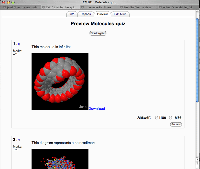Jmol filter: Difference between revisions
Dan Stowell (talk | contribs) mNo edit summary |
Dan Stowell (talk | contribs) (Added how-to) |
||
| Line 13: | Line 13: | ||
* [http://moodle.yeovil.ac.uk/course/view.php?id=63 See it in action in this course] (Log in as guest) | * [http://moodle.yeovil.ac.uk/course/view.php?id=63 See it in action in this course] (Log in as guest) | ||
===How to use=== | |||
# Upload a molecule data file to the Moodle server. (This is important - Jmol refuses to display data files held on other servers, so you can't just link to a file that exists somewhere else on the web.) | |||
# Simply create a link to the molecule file, wherever you want the molecule viewer to appear. | |||
::* Parameters can be added to the end of the URL to specify certain display options. Add "?c=0" to hide the controls, or "?s=150" to set the viewer's size at 150 pixels. Or "?c=0&s=150" to do both. | |||
# If you wish to run extra Jmol script upon intialisation, include this '''immediately''' after the link, and enclose it in JMOLSCRIPT{}. For example: | |||
[http://cvs.sf.net/viewcvs.py/*checkout*/moodle/contrib/filter_jmol/filter/jmol/manywater.pdb Water molecules] JMOLSCRIPT{rotate x 15; zoom 50; set axes on;} | |||
[[Category:Administrator]] | [[Category:Administrator]] | ||
[[Category:Filter]] | [[Category:Filter]] | ||
Revision as of 11:45, 29 March 2006
Jmol is open-source Java software for interactive 3D viewing of molecular structures. It can easily be embedded into a webpage... including a Moodle page.
The Moodle Jmol filter is recently developed but comes as a single download and is easy to use and install.
The Jmol filter is very useful for including a molecule viewer in a variety of situations - e.g. in a Label, a Forum discussion, or a Quiz question. If you wish to load a molecule data file as a "resource", you should also consider installing the Jmol resource module.
It requires no additional capability on your web server, but is a Java applet, added to the page with JavaScript controls, so requires both Java and a JavaScript-enabled browser for the user.
- See it in action in this course (Log in as guest)
How to use
- Upload a molecule data file to the Moodle server. (This is important - Jmol refuses to display data files held on other servers, so you can't just link to a file that exists somewhere else on the web.)
- Simply create a link to the molecule file, wherever you want the molecule viewer to appear.
- Parameters can be added to the end of the URL to specify certain display options. Add "?c=0" to hide the controls, or "?s=150" to set the viewer's size at 150 pixels. Or "?c=0&s=150" to do both.
- If you wish to run extra Jmol script upon intialisation, include this immediately after the link, and enclose it in JMOLSCRIPT{}. For example:
Water molecules JMOLSCRIPT{rotate x 15; zoom 50; set axes on;}
